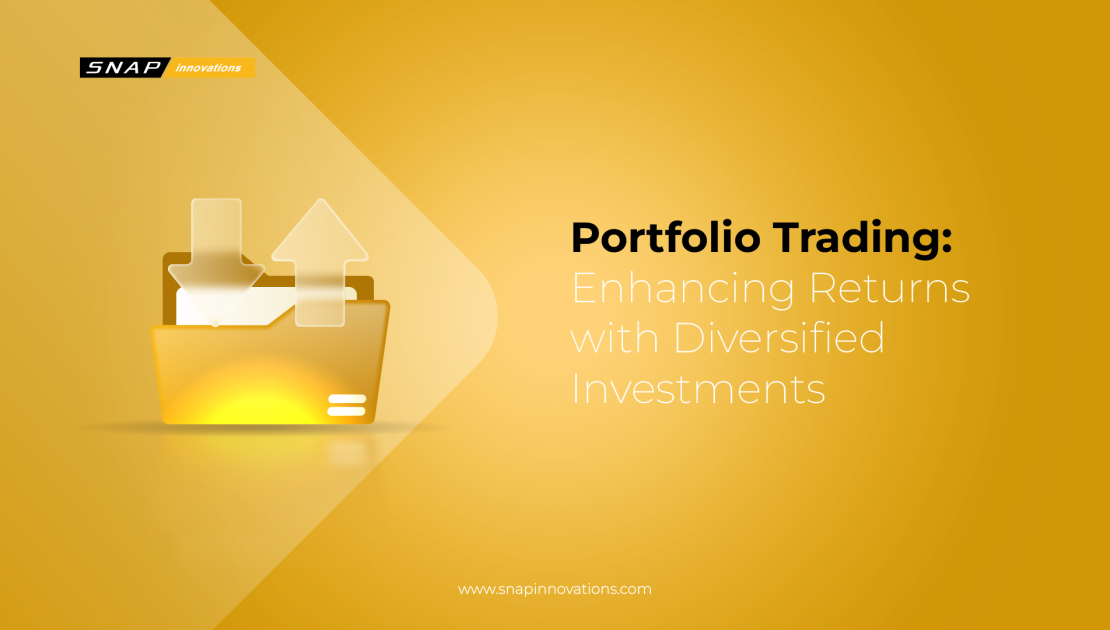In today’s dynamic financial landscape, investors are constantly seeking ways to optimize their returns while managing risks effectively. One strategy that has gained popularity in recent years is portfolio trading.
By diversifying investments across a range of assets, portfolio trading aims to spread risk and maximize returns. In this guide, we’ll delve into the fundamentals of portfolio trading, exploring its benefits, strategies, and best practices to help you achieve your investment goals.
What is Portfolio Trading?
Portfolio trading is a sophisticated investment strategy that involves managing a portfolio of assets to achieve specific financial objectives. Unlike traditional trading, which typically involves buying and selling individual securities, portfolio trading focuses on the broader picture, taking into account the overall performance of the portfolio as a whole. The goal of portfolio trading is to achieve a balance between risk and return by diversifying investments across different asset classes, sectors, and geographic regions. By spreading investments across multiple assets, investors can reduce the impact of any single investment on their overall portfolio performance, thereby reducing risk and potentially enhancing returns.
Portfolio trading involves several key steps. First, investors must define their investment objectives and risk tolerance, taking into account factors such as their financial goals, time horizon, and liquidity needs. Once these objectives are established, investors can then design a portfolio that aligns with their investment goals and risk profile. This typically involves selecting a mix of assets, such as stocks, bonds, commodities, and real estate, that offer different levels of risk and return potential.
Next, investors must implement their portfolio strategy by purchasing the selected assets and allocating capital according to their desired asset allocation. This may involve rebalancing the portfolio periodically to maintain the desired asset mix and risk profile. Finally, investors must monitor the performance of their portfolio regularly and make adjustments as needed to ensure that it remains aligned with their investment objectives and risk tolerance.
Benefits of Portfolio Trading
Portfolio trading offers several benefits for investors looking to optimize their returns and manage risk effectively.
1. Enhanced Risk Management
Portfolio trading offers investors a sophisticated approach to risk management by allowing them to diversify their investments across a broad range of asset classes, industries, and geographic regions. This diversification helps to reduce the impact of any single investment’s performance on the overall portfolio. By spreading their capital across multiple securities with different risk profiles, investors can minimize the potential for significant losses in the event of adverse market movements or unforeseen events.
Furthermore, portfolio trading enables investors to implement various risk management techniques, such as asset allocation, rebalancing, and hedging strategies, to further mitigate portfolio risk and enhance stability. Through careful portfolio construction and ongoing monitoring, investors can tailor their risk exposure to align with their individual risk tolerance and investment objectives, ultimately preserving capital and achieving more consistent long-term returns.
2. Improved Return Potential
Diversification, a cornerstone of portfolio trading, not only helps to manage risk but also enhances the potential for higher returns. By spreading investments across different asset classes, such as stocks, bonds, real estate, and alternative investments, investors can capitalize on the unique return characteristics of each asset class. For example, while stocks offer the potential for capital appreciation, bonds provide income through interest payments and can act as a buffer during market downturns.
By combining assets with different return drivers and correlation patterns, portfolio trading aims to capture upside potential while mitigating downside risk, resulting in more consistent and attractive risk-adjusted returns over time. Additionally, portfolio trading allows investors to take advantage of diversification benefits such as the efficient frontier and the risk-return tradeoff, enabling them to optimize their investment portfolios for maximum return potential based on their risk preferences and investment horizon.
Also Read: Trading Schools: Your Gateway to Becoming a Trading Expert
3. Tailored Investment Strategies
Portfolio trading empowers investors to design customized investment strategies tailored to their unique financial goals, time horizon, and risk tolerance. Unlike traditional investment approaches that offer limited flexibility, portfolio trading allows investors to construct portfolios that reflect their individual preferences and objectives. For instance, investors may choose to allocate assets based on factors such as their age, income needs, liquidity requirements, and market outlook.
Additionally, portfolio trading enables investors to incorporate specialized investment strategies such as value investing, growth investing, momentum trading, and factor-based investing into their portfolios to achieve specific financial outcomes. By aligning their investment strategies with their long-term objectives and risk preferences, investors can enhance the likelihood of achieving their financial goals while maintaining a disciplined and systematic approach to portfolio management.
4. Reduced Volatility
Volatility, or the degree of variation in the price of a financial instrument over time, can be a significant source of uncertainty and risk for investors. However, portfolio trading offers a powerful solution for reducing portfolio volatility and smoothing out investment returns. Through diversification, investors can spread their capital across assets with low or negative correlations, such as stocks, bonds, commodities, and currencies, thereby reducing the overall volatility of their portfolios. By combining assets with different risk-return profiles and performance drivers, portfolio trading aims to achieve a more stable and predictable investment outcome, even in the face of market turbulence or economic uncertainty.
Additionally, portfolio trading allows investors to implement risk management techniques such as stop-loss orders, option strategies, and dynamic asset allocation to further mitigate portfolio volatility and protect against downside risk. By actively managing volatility, investors can enhance the resilience of their portfolios and improve their ability to achieve their long-term financial objectives.
5. Increased Liquidity
Liquidity refers to the ease with which an asset can be bought or sold in the market without significantly impacting its price. Portfolio trading emphasizes liquidity as a critical factor in portfolio construction and management, as it enables investors to access their capital quickly and efficiently when needed. By investing in liquid assets such as stocks, bonds, exchange-traded funds (ETFs), and mutual funds, investors can ensure that their portfolios remain flexible and responsive to changing market conditions. Additionally, portfolio trading allows investors to optimize their portfolio liquidity by carefully selecting assets with high trading volumes, tight bid-ask spreads, and minimal transaction costs.
This focus on liquidity not only enhances investors’ ability to execute trades seamlessly but also provides them with greater confidence and peace of mind knowing that they can easily access their funds whenever necessary. Moreover, portfolio trading enables investors to take advantage of market opportunities as they arise, capitalize on short-term trading opportunities, and rebalance their portfolios efficiently to maintain optimal asset allocation.
6. Tax Efficiency
Taxes can significantly impact investment returns, making tax efficiency a critical consideration for investors. Portfolio trading offers numerous strategies and techniques to minimize tax liabilities and maximize after-tax returns. One such strategy is tax-loss harvesting, which involves selling securities at a loss to offset capital gains and reduce taxable income. By strategically harvesting losses and reinvesting the proceeds in similar but not substantially identical securities, investors can lower their tax bills and enhance their overall investment returns.
Additionally, portfolio trading enables investors to optimize their asset location by strategically allocating assets across taxable and tax-advantaged accounts such as individual retirement accounts (IRAs) and 401(k) plans. By holding tax-inefficient assets in tax-advantaged accounts and tax-efficient assets in taxable accounts, investors can minimize the impact of taxes on their investment returns and maximize their after-tax wealth accumulation. Moreover, portfolio trading allows investors to implement tax-efficient investment strategies such as index fund investing, dividend reinvestment, and tax-exempt bond investing to further enhance their tax efficiency and improve their long-term financial outcomes.
7. Long-Term Wealth Accumulation
Ultimately, the primary goal of portfolio trading is to achieve long-term wealth accumulation and financial security. By adopting a disciplined and systematic approach to portfolio management, investors can build diversified investment portfolios that grow steadily over time, generating consistent returns and compounding wealth for the future. Through strategic asset allocation, active risk management, and tax-efficient investing, portfolio trading enables investors to achieve their financial goals while minimizing risk and maximizing returns.
Whether saving for retirement, funding education expenses, or building a legacy for future generations, portfolio trading provides investors with the tools, strategies, and resources needed to achieve financial independence and secure their financial future. By leveraging the benefits of portfolio trading and staying committed to their long-term investment objectives, investors can navigate the complexities of the financial markets with confidence and achieve lasting success in their wealth accumulation journey.
Strategies for Successful Portfolio Trading
 Successful portfolio trading requires careful planning, disciplined execution, and ongoing monitoring. Here are some key strategies to consider:
Successful portfolio trading requires careful planning, disciplined execution, and ongoing monitoring. Here are some key strategies to consider:
1. Asset Allocation
Asset allocation is a cornerstone of successful portfolio trading, involving the strategic distribution of investments across different asset classes such as stocks, bonds, real estate, and commodities. By diversifying across asset classes with varying risk-return profiles, investors can achieve a balance between potential returns and risk exposure. This strategy helps to mitigate the impact of market volatility and optimize portfolio performance over the long term.
Additionally, asset allocation allows investors to capitalize on the growth potential of different market segments while cushioning against downturns in any single sector or asset class. Through careful analysis of market trends, economic indicators, and individual investment goals, investors can tailor their asset allocation to match their risk tolerance and investment objectives, maximizing the potential for long-term wealth accumulation.
2. Diversification
Diversification is a fundamental principle of portfolio trading, aimed at spreading investment risk across multiple securities or asset classes. Through diversification, investors can reduce the impact of any single investment’s performance on the overall portfolio. By combining assets with low correlations, investors can smooth out portfolio volatility and enhance risk-adjusted returns.
Diversification also provides protection against idiosyncratic risks specific to individual securities or sectors, helping to preserve capital and maintain portfolio stability. Moreover, diversification extends beyond asset classes to encompass geographic regions, industries, and investment styles, ensuring that the portfolio remains resilient to various market conditions and economic environments.
3. Rebalancing
Rebalancing involves periodically adjusting the asset allocation of a portfolio to maintain desired risk and return characteristics. As asset values fluctuate over time, the original asset allocation may deviate from the target allocation, leading to unintended portfolio drift. Rebalancing allows investors to realign their portfolios with their long-term investment objectives by buying or selling assets to restore the desired asset mix.
This disciplined approach helps to control risk, capture investment opportunities, and ensure that the portfolio remains aligned with the investor’s risk tolerance and financial goals. Additionally, rebalancing provides an opportunity to capitalize on market inefficiencies and exploit asset mispricings, enhancing overall portfolio performance and efficiency.
4. Risk Management
Effective risk management is essential for successful portfolio trading, as it helps investors navigate market uncertainties and protect their capital. Risk management strategies may include setting stop-loss orders to limit potential losses, using options to hedge against adverse price movements, and employing position sizing techniques to control portfolio exposure.
By identifying and mitigating potential risks, investors can preserve capital, minimize losses, and enhance the stability of their investment portfolios. Moreover, risk management extends beyond individual trades to encompass broader portfolio considerations such as asset class correlations, volatility analysis, and scenario planning, ensuring that the portfolio remains resilient to adverse market events and economic shocks.
5. Cost Control
Cost control is a critical aspect of portfolio trading, as excessive trading costs can erode investment returns over time. Investors should seek to minimize trading commissions, bid-ask spreads, and other transaction costs associated with portfolio trading. This may involve using low-cost investment vehicles such as index funds and ETFs, choosing cost-effective trading platforms, and optimizing trade execution to reduce slippage.
By controlling costs, investors can improve the overall efficiency of their portfolio trading strategies and maximize their net investment returns. Additionally, cost control allows investors to allocate more capital to productive investments, compounding the effects of returns over time and enhancing long-term wealth accumulation.
6. Continuous Monitoring and Adjustment
Successful portfolio trading requires ongoing monitoring and adjustment to respond to changing market conditions and investment opportunities. Investors should regularly review their portfolios, assess performance relative to goals, and make adjustments as needed to stay on track. This may involve reallocating assets based on market trends, rebalancing to maintain desired risk levels, and incorporating new investment opportunities that align with long-term objectives.
By staying vigilant and adaptive, investors can optimize their portfolio trading strategies and position themselves for long-term success in the financial markets. Additionally, continuous monitoring allows investors to identify emerging trends, capitalize on market inefficiencies, and adapt their portfolios to evolving market dynamics, maximizing the potential for investment success and wealth accumulation.
Tools and Resources for Portfolio Trading
 When it comes to portfolio trading, having access to the right tools and resources can make all the difference in achieving investment success. One essential tool for portfolio traders is a robust trading platform that offers advanced charting tools, real-time market data, and customizable trading interfaces. These platforms allow traders to execute trades efficiently, analyze market trends, and monitor their portfolios in real time.
When it comes to portfolio trading, having access to the right tools and resources can make all the difference in achieving investment success. One essential tool for portfolio traders is a robust trading platform that offers advanced charting tools, real-time market data, and customizable trading interfaces. These platforms allow traders to execute trades efficiently, analyze market trends, and monitor their portfolios in real time.
Additionally, portfolio traders can benefit from using risk management software to assess portfolio risk, identify potential vulnerabilities, and implement strategies to mitigate risk exposure. Moreover, research tools such as financial news websites, research reports, and economic calendars provide valuable insights into market trends, economic indicators, and company fundamentals, helping traders make informed investment decisions.
Another essential resource for portfolio traders is access to educational materials such as books, courses, and webinars, which can help them deepen their understanding of trading strategies, market dynamics, and investment principles. Additionally, social trading platforms allow traders to connect with other investors, share ideas, and collaborate on trading strategies, enhancing their trading experience and performance. Overall, leveraging these tools and resources can empower portfolio traders to navigate the complexities of the financial markets with confidence and achieve their investment goals.
The Future of Portfolio Trading
 The future of portfolio trading is intricately tied to the rapid advancements in technology and the evolving nature of global financial markets. With the increasing integration of artificial intelligence and machine learning algorithms, portfolio traders can anticipate a transformation in data analysis and predictive modeling, leading to more accurate risk assessments and investment strategies. Additionally, the proliferation of data sources and analytics tools is expected to provide traders with greater insights into market trends and opportunities, enabling them to make more informed decisions and optimize portfolio performance.
The future of portfolio trading is intricately tied to the rapid advancements in technology and the evolving nature of global financial markets. With the increasing integration of artificial intelligence and machine learning algorithms, portfolio traders can anticipate a transformation in data analysis and predictive modeling, leading to more accurate risk assessments and investment strategies. Additionally, the proliferation of data sources and analytics tools is expected to provide traders with greater insights into market trends and opportunities, enabling them to make more informed decisions and optimize portfolio performance.
Furthermore, the emergence of blockchain technology and cryptocurrency markets presents both challenges and opportunities for portfolio traders. While blockchain-based assets offer new avenues for diversification and potential high returns, they also introduce complexities related to security, regulation, and market volatility. Portfolio traders must stay abreast of developments in the blockchain space and adapt their strategies accordingly to capitalize on emerging trends while managing associated risks effectively.
Moreover, the rise of environmental, social, and governance (ESG) investing is reshaping the investment landscape, with portfolio traders increasingly incorporating sustainability criteria into their decision-making processes. As investors place greater emphasis on ESG factors, portfolio trading strategies are likely to evolve to align with these changing preferences, driving a shift towards more socially responsible investment practices.
Also Read: Trading Roadmap: Your Guide to Navigating the Financial Markets
Conclusion
In conclusion, portfolio trading offers investors a powerful strategy for maximizing returns and managing risk effectively. By diversifying investments across different asset classes, sectors, and geographic regions, investors can reduce their exposure to any single investment or market, while potentially enhancing returns over time.
Successful portfolio trading requires careful planning, disciplined execution, and ongoing monitoring, as well as access to the right tools and resources. With the right approach and a commitment to continuous learning and improvement, investors can navigate the dynamic world of financial markets and achieve their investment objectives through portfolio trading.

